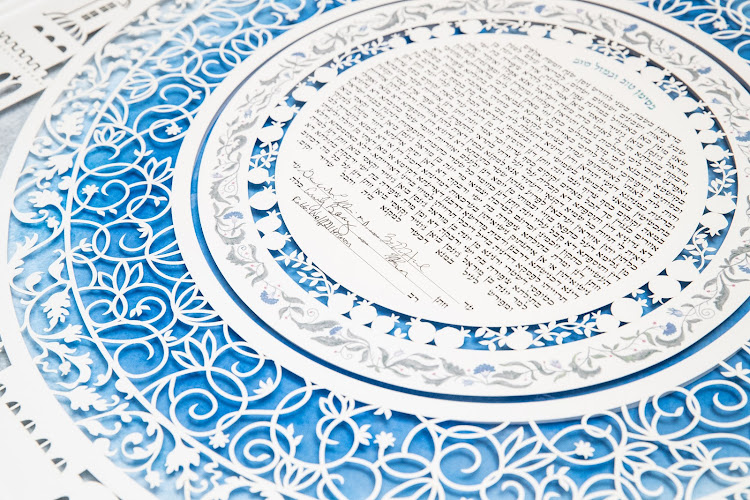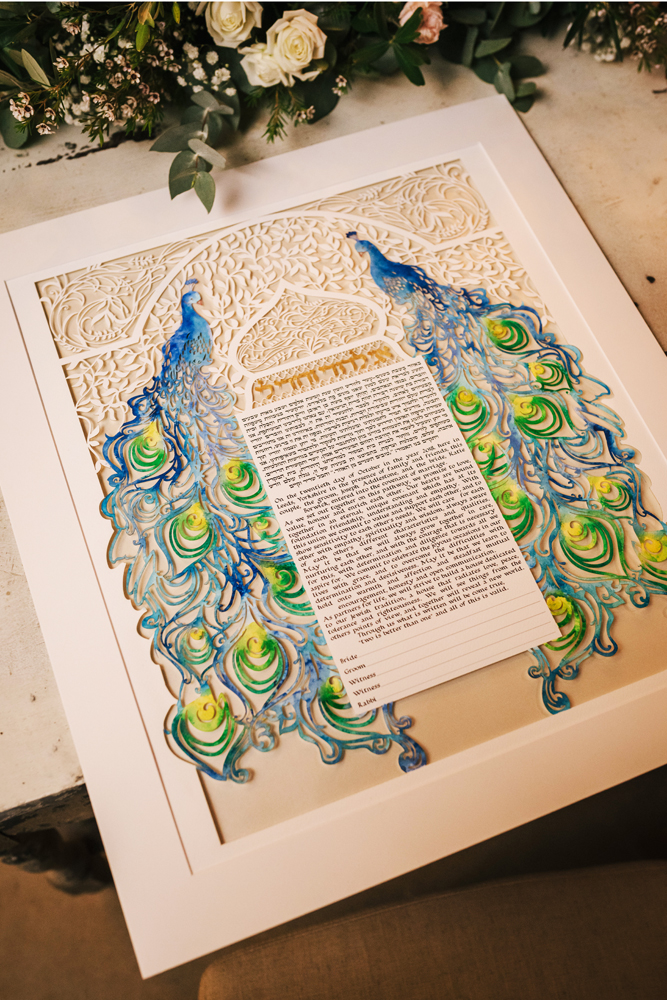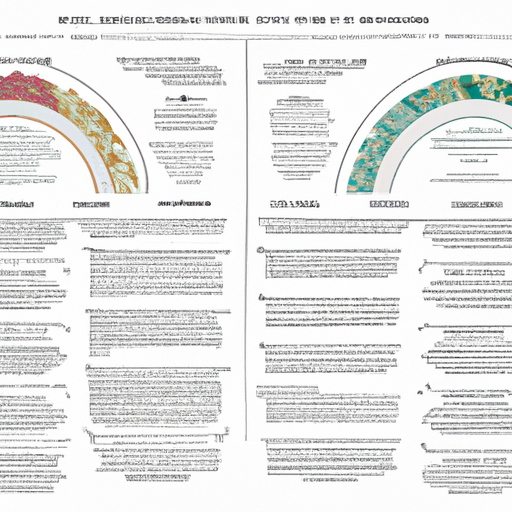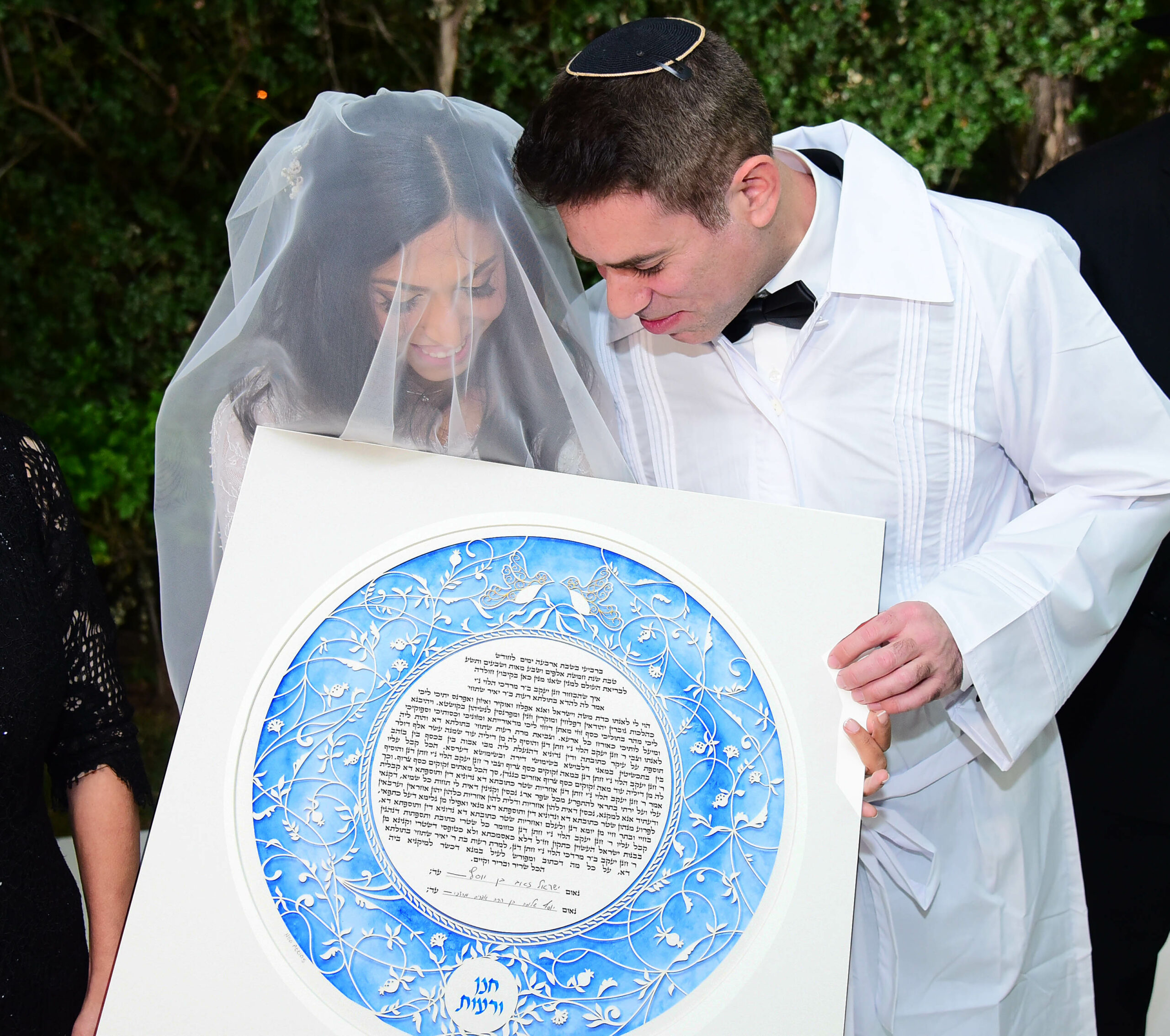This guide seeks to illuminate the significant differences and similarities between traditional and contemporary ketubah styles. The text elucidates the historical contexts, aesthetic aspects, and the cultural significance of both styles. It aims to empower readers to make an informed choice between the two styles, based on their personal preference and the relevance of each style to their ceremonial needs.
Understanding the Ketubah: What's in a Contract?
The Ketubah holds significant importance in Jewish tradition, serving as a marriage contract that outlines the rights and responsibilities of the couple. Within this document, several key elements are included to solidify the commitment between partners and establish a framework for their union.
Firstly, the Ketubah specifies the financial obligations of the husband towards his wife, ensuring her security in the event of divorce or his passing. This aspect reflects the historical context of the Ketubah as a means of protecting women's rights and ensuring their well-being within the marriage.
Secondly, the Ketubah often includes provisions related to the couple's living arrangements, such as the husband's commitment to provide a home for his wife and the wife's responsibilities within the household. These clauses serve to establish the foundation of the couple's domestic life and mutual obligations towards each other.
Finally, the Ketubah may also contain ethical and moral commitments that the couple agrees to uphold throughout their marriage. These values can range from principles of respect and kindness towards one another to promises of mutual support and partnership in facing life's challenges.

A beautifully written ketubah in hebrew
Traditional Ketubah: Echoing the Past in the Present?
The traditional Ketubah embodies centuries of Jewish customs and values, reflecting a deep connection to the heritage and rituals of the past. Rooted in tradition, the classic Ketubah design often features intricate motifs, elegant calligraphy, and symbolic imagery that pay homage to the rich history of Jewish marriage customs.
With its timeless aesthetic and reverent language, the traditional Ketubah serves as a link between generations, echoing the commitments made by countless couples before. The use of traditional Aramaic text, dating back to ancient times, adds a sense of continuity and authenticity to the document, emphasizing the enduring nature of the marital bond it represents.
Many couples choose a traditional Ketubah not only for its cultural significance but also for the sense of heritage and continuity it brings to their union. By embracing the traditional style, couples can honor their roots, celebrate their shared history, and create a lasting testament to their love that transcends time and trends.
Contemporary Ketubah: A Modern Take on an Age-Old Tradition
In the realm of Ketubah styles, the contemporary approach offers a fresh perspective on the age-old tradition of creating a marriage contract. By infusing modern design elements, innovative language, and personalized touches, the contemporary Ketubah reflects the evolving nature of relationships and the diverse identities of couples today.
- Embracing Individuality:
One key aspect of contemporary Ketubahs is their emphasis on individuality and personal expression. In contrast to the standardized format of traditional Ketubahs, contemporary designs often allow for greater customization, enabling couples to incorporate elements that reflect their unique personalities, values, and love story. From abstract art to digital illustrations, the contemporary Ketubah provides a canvas for couples to express themselves in a way that resonates with their modern sensibilities. - Exploring Diverse Themes:
Another characteristic of contemporary Ketubahs is their exploration of diverse themes beyond the traditional motifs found in classic designs. From nature-inspired imagery to geometric patterns and minimalist aesthetics, contemporary Ketubahs draw inspiration from a wide range of sources, reflecting the eclectic tastes and interests of couples seeking a more personalized and non-traditional approach to their marriage contract.

A side-by-side comparison of traditional and contemporary ketubahs
"Innovation or Disruption?": The Debate Around Contemporary Ketubah
"Innovation or Disruption?": The Debate Around Contemporary Ketubah:
The emergence of contemporary Ketubah styles has sparked a lively debate within the Jewish community and among couples seeking to redefine the traditional boundaries of this sacred document. While some view contemporary Ketubahs as a refreshing and relevant update to an ancient tradition, others raise concerns about the potential erosion of the Ketubah's historical significance and ritual importance. The question of whether contemporary Ketubahs represent innovation or disruption hinges on differing perspectives regarding the sanctity of marriage contracts and the role of tradition in shaping modern relationships.
Proponents of contemporary Ketubahs argue that these modern interpretations breathe new life into a centuries-old practice, making it more inclusive, accessible, and meaningful for today's diverse couples. By embracing contemporary design trends, language choices, and thematic elements, these advocates believe that the Ketubah can better reflect the evolving values and identities of couples in the 21st century. They see innovation as a natural progression that honors tradition while embracing change and adapting to the times.
Juxtaposing Design Elements: What Sets Them Apart?
When comparing traditional and contemporary Ketubah styles, one of the most striking differences lies in their design elements, which play a crucial role in conveying the essence and significance of the marital commitment. By examining the visual aesthetics, artistic motifs, and symbolic representations employed in each style, it becomes evident how these design choices contribute to the overall message and tone of the Ketubah.
- 1. Traditional Design Elements:
Rooted in History and Symbolism
Traditional Ketubahs often feature intricate calligraphy, ornate borders, and classic motifs such as the Tree of Life, doves, or the Jerusalem skyline. These design elements are steeped in rich symbolism and cultural significance, reflecting the time-honored traditions and values of Jewish marriage. The use of traditional Hebrew text and elaborate decorations serves to emphasize the solemnity and reverence associated with the Ketubah as a sacred covenant between partners. - 2. Contemporary Design Elements:
Embracing Innovation and Personalization
In contrast, contemporary Ketubahs showcase a more diverse range of design elements that reflect the individual tastes, preferences, and identities of modern couples. From minimalist typography and abstract art to whimsical illustrations and vibrant colors, contemporary Ketubahs offer a fresh and personalized approach to visual storytelling. By incorporating unconventional themes, modern imagery, and unconventional layouts, contemporary Ketubahs invite couples to express their unique love story in a creative and personalized manner.

A detailed infographic comparing the design elements of traditional and contemporary ketubahs
What Does Your Ketubah Say About You?
Your choice of Ketubah style can reveal a great deal about your personality, values, and aspirations as a couple. Here are three key aspects to consider when reflecting on what your Ketubah says about you:
- 1. Cultural Identity and Heritage:
The design elements and motifs incorporated into your Ketubah can serve as a reflection of your cultural identity and heritage. Traditional Ketubah styles often feature symbols and imagery with deep historical and religious significance, highlighting a connection to Jewish tradition and heritage. On the other hand, contemporary Ketubahs offer a platform for couples to infuse their cultural backgrounds and personal experiences into the design, showcasing a blend of tradition and modernity that speaks to their unique identity as a couple. - 2. Artistic Expression and Personal Taste:
The aesthetic design of your Ketubah speaks volumes about your artistic sensibilities and personal taste as a couple. Whether you are drawn to the timeless elegance of traditional calligraphy and intricate illustrations or prefer the bold and innovative designs of contemporary art, your Ketubah serves as a canvas for expressing your shared aesthetic preferences and creative vision. By selecting a Ketubah style that resonates with your artistic sensibilities, you are not only creating a meaningful symbol of your commitment but also showcasing your individuality and taste as a couple.
Making the Choice: How Do You Envision Your Commitment?
When choosing between traditional and contemporary Ketubah styles, it is essential to reflect on how you envision your commitment as a couple. This decision goes beyond mere aesthetics and design preferences; it is a statement of your values, beliefs, and aspirations for your relationship. Here are three key considerations to help you make an informed choice:
- 1. Tradition vs. Innovation:
Consider how you perceive the role of tradition in your relationship. Traditional Ketubah styles uphold centuries-old customs and rituals, emphasizing the importance of continuity and heritage in your commitment. On the other hand, contemporary Ketubah designs offer a fresh and innovative approach, allowing you to reinterpret tradition through a modern lens. Reflect on whether you value the time-honored practices that have guided couples for generations or if you seek to forge a new path that reflects your unique bond. - 2. Personalization and Individuality:
Think about how you want to personalize your Ketubah to reflect your relationship's unique qualities and shared experiences. Traditional Ketubahs often follow a standard format with prescribed texts and designs, while contemporary Ketubahs offer greater flexibility for customization. Consider whether you prefer a Ketubah that speaks to your individuality as a couple, allowing you to incorporate personal touches and meaningful symbols that resonate with your love story. Your choice between traditional and contemporary styles can shape the level of personalization and creativity you bring to this sacred document.

A couple deeply engrossed their perfect ketubah
There is no 'one size fits all' when it comes to choosing a ketubah. Whether you lean towards a traditional or a contemporary style, the decision should ultimately reflect your unique journey and the bond you share with your partner. Both styles carry their own charm and significance, and your choice will add a personal touch to your special day. We hope this guide has been helpful in showing you the beauty and depth of both traditional and contemporary ketubah styles.
https://noaattias.com/
